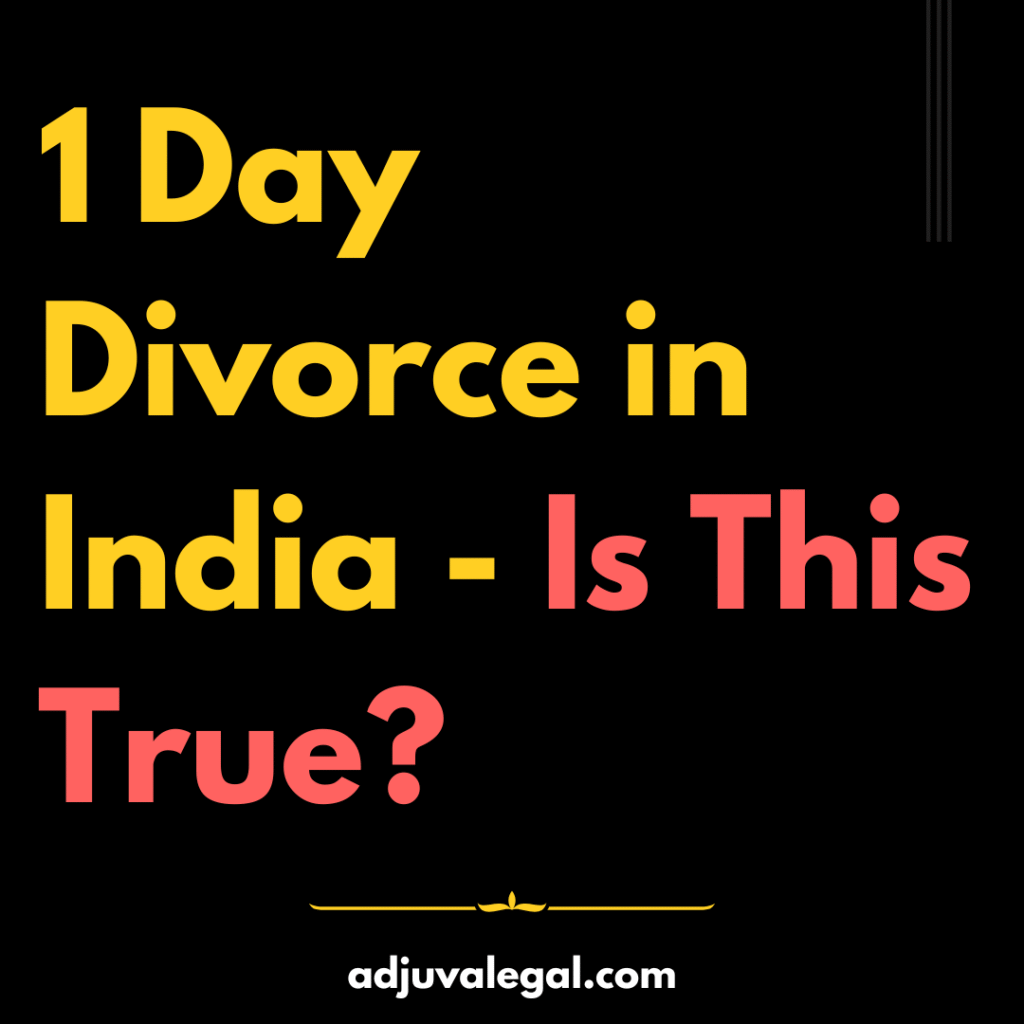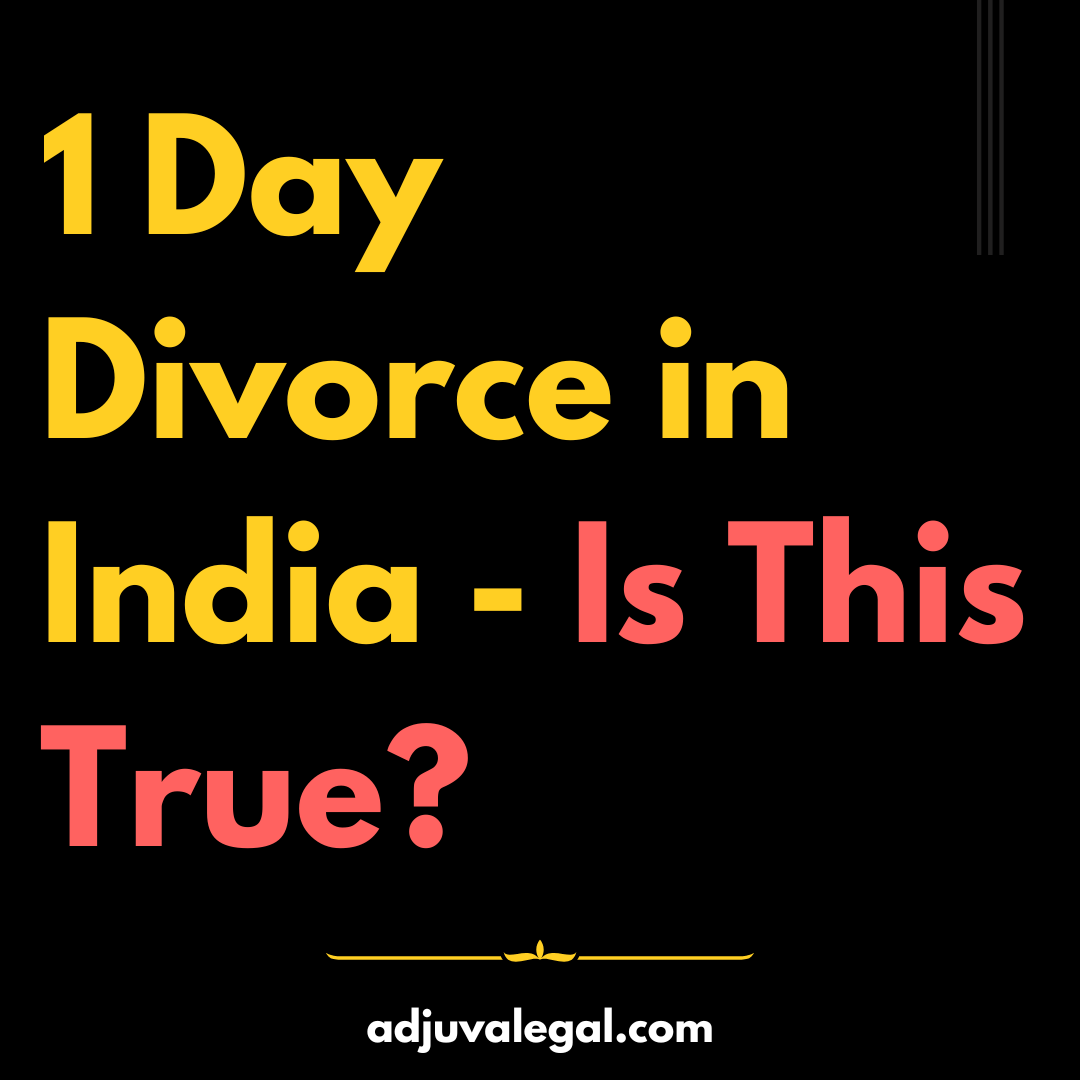Ending a marriage brings a wave of emotions, and it’s natural to want the process over quickly. Many in India might search for or dream of a “1 day divorce” – a swift end to a difficult chapter.
While the desire for speed is understandable, it’s crucial to know that a literal 1 day divorce process isn’t legally possible within the standard Indian judicial system.
So, what’s the truth? What is the actual fastest way to get divorced in India? This article clarifies the “1 day divorce” myth and highlights the real fastest path: Divorce by Mutual Consent, focusing on its significant benefits.
What Do People Mean by “1 Day Divorce”?
The term “1 day divorce” usually reflects:
- A Hope for Speed: The desire for the quickest possible legal end to the marriage.
- The Final Court Date: Referring to the single day the judge issues the final divorce decree, which follows a much longer process.
- Quick Filing: Some services might help prepare and file the initial divorce petition rapidly, but this only starts the journey.

The Fastest Route in India: Divorce by Mutual Consent
The quickest and generally least painful way to legally end a marriage in India is Divorce by Mutual Consent. Governed by Section 13B of the Hindu Marriage Act, 1955 (with similar laws for other communities), this process is designed for couples who have both decided the marriage cannot continue.
Key Requirements for a Mutual Divorce:
- Mutual Agreement: Both spouses must agree to the divorce.
- One Year Separation: You must have lived apart for at least one year before filing.
- Agreement on Terms: Crucially, you both must agree on alimony/maintenance, child custody arrangements, and how property/assets will be divided.
- Irretrievable Breakdown: Both must state you cannot live together and mutually agree the marriage should end.
Why Choose Mutual Consent? The Clear Benefits:
Beyond being the fastest route, mutual consent divorce offers significant advantages, especially compared to contested proceedings:
- Less Acrimony & Stress: Since both parties agree, it avoids lengthy battles, accusations, and the emotional drain of fighting in court. This preserves dignity and reduces stress for everyone involved, including families.
- Cost-Effective: Contested divorces involve multiple hearings, extensive lawyer fees, and other costs that can escalate quickly. Mutual consent significantly reduces these expenses.
- Faster Resolution: Even with the waiting period (discussed below), it’s far quicker than a contested divorce which can drag on for years.
- Certainty of Outcome: You both decide the terms of the settlement (alimony, custody, property). This gives you control and predictability, unlike leaving decisions entirely up to a judge.
- Privacy & Confidentiality: Courtroom battles are public. Mutual consent discussions and agreements are generally private, protecting your personal matters from public scrutiny.
- Better for Children: Minimising conflict is crucial for children’s well-being during a divorce. A cooperative approach helps establish a more stable co-parenting foundation for the future.
If you're feeling trapped in a dead marriage, don't give up! Reach out to Adjuva Legal today.
The Standard Process & Timeline:
- First Motion: A joint petition is filed. Statements are recorded.
- Waiting Period: A mandatory 6-month “cooling-off” period begins (up to 18 months). This is legally required to allow time for potential reconciliation.
- Second Motion: After 6 months (and before 18), both parties reaffirm their consent in court.
- Final Decree: The court grants the divorce.

Skipping the Wait: The 6-Month Waiver
Can the process be faster? Yes. The Supreme Court (Amardeep Singh vs. Harveen Kaur, 2017) confirmed that the 6-month cooling-off period can be waived by the family court if:
- You’ve already been separated for a significant period (well over the initial one year).
- All issues (alimony, custody, etc.) are fully settled.
- There’s absolutely no chance of reconciliation.
- Waiting further would only cause hardship.
If a waiver is granted, the time frame shrinks considerably, potentially to a few months.
Still, it involves court procedures and isn’t instantaneous.
Contested Divorce: The Slow Alternative
If agreement isn’t possible, the divorce becomes contested, involving proving grounds for divorce, evidence, witness examinations, and potentially years of litigation. This underscores why mutual consent is favoured for speed and efficiency.
The Final Word on “1 Day Divorce” in India
A “1 day divorce” is a misconception for standard legal procedures in India. While the final decree happens on a specific day, the journey takes time.
The fastest, most beneficial, and least stressful path is Divorce by Mutual Consent.
It offers control, privacy, cost savings, and a quicker resolution than fighting in court.
While the 6-month waiting period is standard, the possibility of a waiver exists for qualifying cases. Ultimately, achieving the quickest possible divorce hinges on mutual agreement and cooperation between both spouses.
FAQs
Is it actually possible to get a complete divorce in just one single day in India?
No, it is not possible to start and finish the entire legal divorce process within a single 24-hour day in India. The term "1 Day Divorce" is a significant misconception. Legal procedures involving filing petitions, court appearances, verification, and judicial orders inherently take more time than that.
If a 1-Day Divorce isn't real, what does the term usually refer to?
The term "1 Day Divorce" generally refers informally to the possibility of waiving the mandatory 6-month cooling-off period in a Mutual Consent Divorce (filed under Section 13B of the Hindu Marriage Act or similar provisions in other personal laws). If the court grants this waiver, the time between the first court appearance (First Motion) and the final hearing (Second Motion) can be drastically reduced, potentially making the final step quicker once prerequisites are met. It does not mean the whole process happens in a day.
What is the actual fastest way to get a divorce in India, then?
The fastest legal route to divorce in India is through Mutual Consent. This requires both spouses to agree on dissolving the marriage and settle all related issues (like alimony, child custody, property division). They must typically prove they have lived separately for at least one year. The process can be expedited further if they successfully apply for and are granted a waiver of the 6-month statutory cooling-off period by the court.
Can anyone get the 6-month cooling-off period waived to speed up their divorce?
No, the waiver is not automatic and is granted solely at the discretion of the court. Based on Supreme Court guidelines (primarily the Amardeep Singh vs. Harveen Kaur case), the court may grant a waiver if specific conditions are met, such as: a long period of prior separation, proof that reconciliation is impossible, confirmation that all issues are amicably settled, and evidence that waiting would only prolong the parties' hardship.
Realistically, how long does the "fastest" divorce (Mutual Consent with waiver) take
Even if the 6-month waiting period is successfully waived, the entire process still takes time. You need to account for filing the initial petition, potentially filing a separate waiver application, court dates for the first motion, the judge considering and deciding on the waiver, and scheduling the second motion/final hearing. Realistically, even the absolute fastest mutual consent divorce with a waiver would likely take at least several weeks to a few months, depending heavily on the specific court's procedures, caseload, and how quickly hearings can be scheduled. It is significantly faster than the standard 7+ months (with the cooling-off period) or the years a contested divorce can take, but definitely not just "1 day".
Author –
Utkarsh Srivastava, founder of award-winning Adjuva Legal, is a renowned divorce consultant with vast experience serving clients globally, particularly in India. He’s a Harvard-trained professional committed to providing high-quality, affordable legal services, exemplified by his pioneering Free Legal Aid Program in India.







